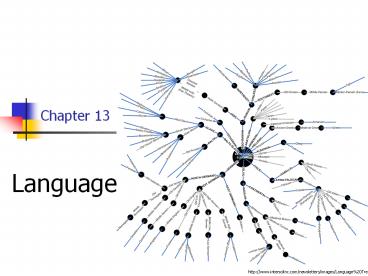Language - PowerPoint PPT Presentation
1 / 24
Title:
Language
Description:
In 1861, Broca examined a patient nicknamed 'Tan,' after the syllable he said most often. ... Savant behaviors. Williams syndrome: low intelligence, but highly verbal ... – PowerPoint PPT presentation
Number of Views:95
Avg rating:3.0/5.0
Title: Language
1
Chapter 13
- Language
http//www.intersolinc.com/newsletters/images/Lang
uage20Tree.gif
2
Paul Broca and Tan
- In 1861, Broca examined a patient nicknamed
Tan, after the syllable he said most often. - The area of damage in Tans case is now known as
Brocas area.
3
- Speech Production and Comprehension
- Aphasia
- Difficulty in producing or comprehending speech
- Caused by brain damage
- Not produced by deafness of a simple motor deficit
4
Important Areas for Language
5
- Speech Production
- Brocas area
- A region of frontal cortex, located just rostral
to the base of the left primary motor cortex,
that is necessary for speech production. - http//video.google.com/videosearch?qaphasiaieU
TF-8oeutf-8rlsorg.mozillaen-USofficialclien
tfirefox-aum1saNtabwv
6
- Speech Production
- Brocas aphasia (production aphasia)
- Speech of others understood, but
- Their own speech is slow, labored, non-fluent
- Characterized by
- difficulty in articulation
- anomia
- agrammatism
7
- Speech Production
- Function word
- Content word
8
- Memory of Words Anomic aphasia
- Anomic aphasia
- Circumlocution
9
- Speech Comprehension
- Wernickes area
- A region of auditory association cortex on the
left temporal lobe of humans, which is important
in the comprehension of words and the production
of meaning speech. http//video.google.com/videos
earch?qaphasiaieUTF-8oeutf-8rlsorg.mozilla
en-USofficialclientfirefox-aum1saNtabwvq
wernickes20aphasiaemb0 - Wernickes aphasia
- A form of aphasia characterized by poor speech
comprehension and fluent but meaningless speech.
10
Brocas and Wernickes Aphasia
- Damage to Wernickes area.
- Speech is fluent, but meaningless.
- Comprehension is very poor.
- Sound substitutions are common.
- Repetition is poor.
- Damage to Brocas area.
- Speech is not fluent.
- Comprehension is affected, but good.
- Repetition is very poor.
11
Conduction Aphasia
- Damage to arcuate fasciculus.
- Speech production is good.
- Comprehension is good.
- Sound substitutions are common.
- Repetition is poor.
12
Global Aphasia
- Damage to Brocas area, Wernickes area and the
arcuate fasciculus. - Abilities to speak, comprehend and repeat are
impaired.
13
Transcortical Aphasia
- Transcortical motor aphasia
- Difficulty producing speech.
- Good comprehension and repetition.
- Transcortical sensory aphasia
- Speech production and repetition are good.
- Comprehension is poor.
14
The Wernicke-Geschwind Model of Aphasia
15
Alexia
- Patients with alexia are unable to read or to
point to words and letters on command. - Patients may write, but are unable to read what
was written. - Ability to recognize words spelled out loud is
retained. - Most cases result from damage to the left
occipital cortex and the corpus callosum.
16
Agraphia
- Damage to motor areas responsible for fine
movements, or - Inability to spell words
- In phonological agraphia, patients cant sound
out words. - cant sound out nonsense words or new words
- can still write familiar words using visual
imagery - In orthographic agraphia, patients cant form
visual images of words to be spelled, but can
spell phonetically.
17
Correlates of Dyslexia
- Less asymmetry in planum temporale
- Differences in the corpus callosum
- Prenatal testosterone and lateralization
- Dyslexia is more common among those who are
left-handed or ambidextrous - Dyslexia is more common among males
- Problems with phonological awareness, spatial
relations, processing rapidly presented stimuli
18
Brain Activation During Reading
- Reader with dyslexia shows less activation of
Wernickes area and the angular gyrus and more
activation of Brocas area.
19
Stuttering
- 1 of the population stutters.
- Stuttering may involve repetition or prolonging
of speech sounds. - 75 of stuttering people are male.
- Stuttering may be genetic.
- People who stutter may lateralize language to the
right hemisphere they show no impairments while
singing. - Treatments include reducing the rate of speech,
reducing stress and providing auditory feedback.
20
Defining Intelligence
- Sternberg and Salter (1982) our ability to
engage in goal-directed adaptive behavior. - A more cynical view intelligence is what
intelligence tests measure.
21
Assessment of Intelligence
- Intelligence testing arose out of compulsory
education laws. - Binet and Simon proposed that bright children
would act more like older children. - Terman adapted Binet and Simons test for
Americans. - Current tests have abandoned the mental age
concept.
22
General vs. Specific Abilities
- Charles Spearman suggested that all intelligence
arises from a single general intelligence (g)
factor. - Howard Gardner proposed that we have multiple,
independent types of intelligence. - Savant behaviors
- Williams syndrome low intelligence, but highly
verbal
23
The Role of Heredity in Intelligence
- Highly debated topic.
- 6080 of variation in intelligence may be due to
heredity. - Identical twins show .95 correlation in gray
matter volume. - Intelligence genes have been elusive.
Thompson et al., 2001
24
Einsteins Brain
- Zaidel (2001)
- Left hippocampal neurons were much larger than
right hippocampal neurons. - This asymmetry was not found in control subjects
with normal intelligence. - Witelson et al. (1999) Einsteins parietal lobe
was about 15 larger than normal.






























